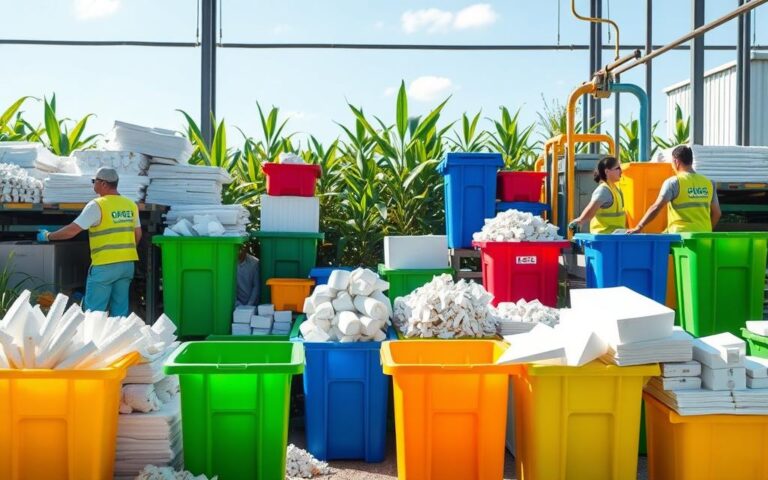Crypto vs Cash: Which Is Worse for the Environment?
The finance world is buzzing with a crucial debate: the environmental impact of cryptocurrency vs regular cash. Digital currencies like Bitcoin are popular. But, we must talk about how they affect our planet. While they’re hailed as a big leap forward, the environmental cost, especially from mining, is often ignored.
Studies show Bitcoin mining creates 62 megatons of CO2 emissions yearly. That’s as much as a whole country like Serbia emits! This fact makes us think hard about the Bitcoin carbon footprint and its impact on Earth.
The environmental toll of traditional cash is also worth looking into. Making and moving cash also hurts the environment. So, deciding which currency is greener involves comparing their environmental effects closely.
With climate change being a pressing issue, we need to look at both cryptocurrency and cash. We should seek greener options in both areas. Columbia University’s Climate School suggests digital currency could help. They believe it could lead to eco-friendly advances. To learn more, read this article.
Introduction to the Environmental Impact of Currency
Digital currencies are changing how our financial systems work. They’re becoming popular for their power to transform economies. But, their rise also brings up worries about their effect on the environment. We must look closely at the environmental costs of both digital and traditional cash.
Understanding Cryptocurrency – A New Financial Era
Cryptocurrencies such as Bitcoin are exciting for investors and innovators. They work outside regular banks, giving people more control over their money. Blockchain technology, which they’re based on, could change many sectors and is drawing a lot of investment. However, we can’t ignore how sustainable cryptocurrencies are.
Bitcoin uses about 151 terawatt-hours of electricity every year. That’s more than some whole countries, like Ukraine. Its carbon footprint is massive, with Bitcoin mining releasing around 55 million tons of CO2 annually. This is as much as a country like Singapore emits.
The Environmental Costs of Traditional Cash Systems
Traditional cash systems also harm the environment. Making and moving notes and coins uses a lot of energy. From making paper to distributing cash, these processes are not as clean as they seem. Yet, they carry big environmental costs.
It’s easy to focus only on digital currencies when talking about environmental impact. But it’s important to see the bigger picture. We need to understand the environmental effects of both digital and traditional cash. This knowledge helps us make better financial decisions with the future in mind.
Energy Consumption of Cryptocurrency Mining
The rise of cryptocurrencies, like Bitcoin, highlights a big worry about energy use. These digital currencies require a lot of power for mining. This is because mining involves solving tough math problems to confirm transactions. Bitcoin mining alone uses about 151 terawatt-hours (TWh) annually. This is as much as some entire countries use, making it a big part of global electricity use.
How Bitcoin Mining Operates
Bitcoin mining is about completing a task called proof-of-work. Miners solve puzzles to validate and secure transactions. This task needs lots of computer power and, as a result, uses lots of energy. Bitcoin’s energy use is about 0.59% of the world’s total. As Bitcoin becomes more popular and valuable, its mining consumes even more electricity. This growth challenges efforts to be sustainable.
The Role of Fossil Fuels in Crypto Mining
The energy for mining mainly comes from fossil fuels, which is worrying. In the US, a big chunk of Bitcoin mining’s power comes from these fuels. In China, about 77% of the energy for mining comes from coal and oil. This heavy use of non-renewable energy sources leads to high carbon emissions. The Bitcoin network is responsible for 55 million tons of CO2 emissions a year. This is about the same as Singapore’s carbon footprint.
This situation has led to criticism for harming the environment. It’s vital for policymakers to act. They need to make rules that reduce the bad impacts of Bitcoin mining on the climate. By imposing stronger regulations and encouraging the use of renewable energy, we can change the situation. This will help solve the problems caused by the intense energy demands of mining.
| Mining Method | Annual Energy Consumption (TWh) | Carbon Emissions (Million Tons) |
|---|---|---|
| Bitcoin | 151 | 55 |
| Ethereum (before PoS) | 5.52 | 35.4 |
| Global Banking Sector | Approx. 300 | N/A |
| Traditional Financial Systems | Lower (fraction of Bitcoin) | N/A |
It’s clear that the energy use in mining, especially Bitcoin, is a big issue. It shapes the discussion on sustainability and efficiency in the digital economy. The growing focus on this issue underlines the need for a detailed comparison of mining methods. We’re looking for ways to a sustainable future.
Water and Land Footprint of Cryptocurrencies
Cryptocurrencies impact the environment more than just through energy use. The water consumed, especially by Bitcoin, shows a great need for resources. Looking at this can teach us the wider effects of digital finance.
Comparing Water Use: Crypto vs Cash
Water, a vital resource, is heavily used in cryptocurrencies. Bitcoin’s global water footprint is startling, matching that of big farms or cities. Bitcoin’s yearly water use runs into hundreds of millions of litres, much more than cash systems. Cash production has its own environmental issues but uses much less water. This difference makes us question how sustainable cryptocurrencies are.
Land Usage for Mining Operations
Bitcoin mining also affects land use severely. It takes up large areas that could support nature. The land needed for mining is more than that for cash flow. The size of data centres and cooling systems for Bitcoin adds to its land footprint. This makes it clear we need greener methods in the cryptocurrency world.

Is Crypto Worse for the Environment Than Cash?
The environmental impact of cryptocurrencies versus cash is a hot topic. Each currency type affects the planet in different ways. Analysing their environmental footprints shows clear differences.
Comparative Analysis of Environmental Footprints
Looking at the crypto vs cash environmental footprint, the variances stand out. Bitcoin, which mostly works on a proof-of-work model, has a larger carbon footprint than cash. Each US cash note costs about $0.26 per year to the environment. Bitcoin’s cost, however, is much higher at about $70 for each coin. Furthermore, Bitcoin uses more than 120 terawatt-hours of energy yearly, making it one of the biggest energy consumers.
While producing and moving cash uses resources, bitcoin mining requires a lot of energy and creates loads of CO2. The environmental cost of US banknotes totals $12.9 billion. This dwarfs Bitcoin’s $1.3 billion. So, compared to cash, the environmental toll of cryptocurrency mining is huge.
Potential for Technological Innovations
New tech in cryptocurrency might lower its environmental harm. Ethereum, for example, has cut its energy use by 99.9% by switching to a proof-of-stake model. The quest for sustainability solutions for mining stresses the importance of renewable energy. A blockchain fuelled by green energy can greatly reduce its eco-impact.
The future of crypto depends on adopting greener tech and saving energy. The industry needs to find eco-friendly solutions. Proper e-waste management will help lessen cryptocurrencies’ environmental footprints.
| Item | Environmental Cost |
|---|---|
| US Cash Note | $0.26 annually |
| Bitcoin | $70 annually |
| Total Cost of US Cash Notes | $12.9 billion |
| Total Cost of Bitcoin | $1.3 billion |
Conclusion
The debate on the environmental implications of money shows a complex link between crypto and traditional cash. Cryptocurrencies like Bitcoin consume a lot of energy, raising big concerns. They use about 120 to 240 terawatt-hours of electricity each year. This is more than many countries use.
Bitcoin’s massive water use is also worrying, with one transaction using around 2,237 gallons. It’s clear we need to change to more eco-friendly ways in the crypto world.
As we move to a digital age, finding a balance is key. Traditional cash also causes environmental harm, but crypto mining’s effects are alarming. Issues like too much water use, making e-waste, and carbon emissions need new ideas and rules. There are promising technologies, like Ethereum’s proof-of-stake, which cuts down on energy use.
The future of cash needs to grow with these changes. Supporting eco-friendly tech and practices in crypto, such as tech waste recycling, is important. Programs like recycling printer cartridges show how we can make finance greener. We must tackle these issues to make a sustainable world where tech does not harm our environment.
FAQ
What is the environmental impact of cryptocurrency compared to cash?
Cryptocurrency, especially Bitcoin, has a big environmental impact. It uses a lot of energy and emits about 55 million tons of carbon each year. That’s as much as some cities.
Cash has its issues too, like using energy for making paper and moving it around. But its carbon footprint is usually smaller than that of cryptocurrencies.
How does Bitcoin mining contribute to climate change?
Mining Bitcoin uses a huge amount of energy, mostly from fossil fuels. This leads to lots of carbon emissions. In fact, about 45% of the energy for Bitcoin comes from coal.
It also creates a lot of electronic waste and uses up important resources.
What are the water and land implications of cryptocurrency mining?
Bitcoin mining uses so much water it could fill over 660,000 Olympic-sized swimming pools. It also needs a big area, over 1,870 square kilometres, for its operations.
This use of water and land outdoes the needs of many people and harms the environment.
Are there any sustainable practices emerging in cryptocurrency?
Yes, there are new ideas to make cryptocurrencies less harmful to the planet. Ethereum, for example, is moving to proof-of-stake. It uses less energy.
This shift could make the digital currency world more sustainable.
Is it possible to balance cryptocurrency innovation with environmental sustainability?
It’s vital to find a balance. We need to look for new ways to make cryptocurrencies with less harm to the environment.
Everyone involved must work together toward sustainability. This is key for keeping the benefits while protecting the planet.
What are the long-term effects of cryptocurrency on the environment?
The future impact depends on making cryptocurrencies greener. If we don’t change the current ways, the damage from high energy use and wasting resources could hurt our planet and worsen climate change.















